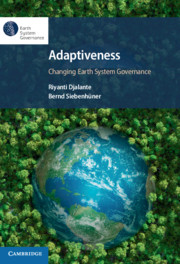Book contents
- Adaptiveness
- Adaptiveness
- Copyright page
- Contents
- Figures
- Tables
- Contributors
- Foreword
- Preface and Acknowledgements
- 1 On Adaptiveness
- 2 Synthesising and Identifying Emerging Issues in Adaptiveness Research within the Earth System Governance Framework (1998–2018)
- 3 Climate Change Adaptive Capacity Assessments
- 4 Assessing the Adaptive Capacity of Collaborative Governance Institutions
- 5 The Marine Debris Nexus
- 6 Synergies and Trade-Offs between Climate Change Adaptation and Mitigation across Multiple Scales of Governance
- 7 Lock-Ins in Climate Adaptation Governance
- 8 Governance and Climate Change Mitigation and Adaptation in Conflict-Affected Countries of Central Africa
- 9 Policy Tools and Capacities for Adaptiveness in US Public Land Management
- 10 Adaptiveness in Earth System Governance
- Index
- References
3 - Climate Change Adaptive Capacity Assessments
Conceptual Approaches and Operational Process
Published online by Cambridge University Press: 22 June 2021
- Adaptiveness
- Adaptiveness
- Copyright page
- Contents
- Figures
- Tables
- Contributors
- Foreword
- Preface and Acknowledgements
- 1 On Adaptiveness
- 2 Synthesising and Identifying Emerging Issues in Adaptiveness Research within the Earth System Governance Framework (1998–2018)
- 3 Climate Change Adaptive Capacity Assessments
- 4 Assessing the Adaptive Capacity of Collaborative Governance Institutions
- 5 The Marine Debris Nexus
- 6 Synergies and Trade-Offs between Climate Change Adaptation and Mitigation across Multiple Scales of Governance
- 7 Lock-Ins in Climate Adaptation Governance
- 8 Governance and Climate Change Mitigation and Adaptation in Conflict-Affected Countries of Central Africa
- 9 Policy Tools and Capacities for Adaptiveness in US Public Land Management
- 10 Adaptiveness in Earth System Governance
- Index
- References
Summary
Over the last decades, adaptive capacity took a greater place on the climate research agenda without receiving sufficient operational attention. There is no consensus on how to define adaptive capacity while existing definitions are often vague. This becomes a challenge when assessing the concept. The objectives of this chapter are two-fold. First, it aims at providing guidance in overcoming the challenges associated with operationalising a concept that has been influenced by different theoretical backgrounds. In order to do so, an operational process composed of three distinct steps is presented to guide future adaptive capacity assessments. Second, the chapter seeks to demonstrate how an operational definition and framework of climate change adaptive capacity that integrate multiple epistemic, spatial, and temporal dimensions can be crafted. By doing so, this chapter unveils a method to identify governance processes fostering adaptiveness as well as the attributes of governance systems enhancing capacities to adapt.
Keywords
- Type
- Chapter
- Information
- Adaptiveness: Changing Earth System Governance , pp. 50 - 68Publisher: Cambridge University PressPrint publication year: 2021
References
- 2
- Cited by

